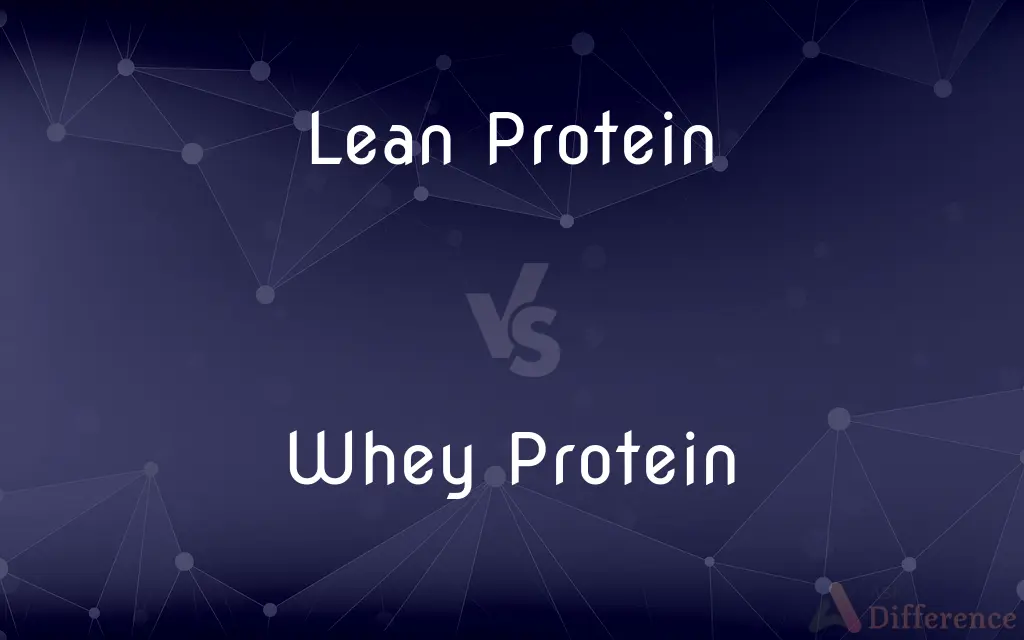Lean Protein vs. Whey Protein — What's the Difference?
By Tayyaba Rehman — Published on November 15, 2023
Lean Protein refers to proteins with low fat content, often from whole foods. Whey Protein is a specific protein derived from milk during cheese-making.

Difference Between Lean Protein and Whey Protein
Table of Contents
ADVERTISEMENT
Key Differences
Lean Protein and Whey Protein are terms commonly used in nutrition and fitness circles. Lean Protein refers to protein sources that are low in fat content. This can include proteins derived from animals or plants. Common sources of Lean Protein include chicken breasts, turkey, fish, and legumes. The emphasis with Lean Protein is on minimizing saturated fat intake, thereby making it a preferred choice for many health-conscious individuals.
Whey Protein, contrastingly, refers specifically to a type of protein found in milk. It's a byproduct of the cheese-making process. When milk is coagulated to make cheese, it separates into solid curds and a liquid whey. This liquid whey is then processed further to extract Whey Protein. Due to its rich amino acid profile, especially its branched-chain amino acids (BCAAs), Whey Protein is popular among athletes and bodybuilders.
While Lean Protein emphasizes the broader category of protein sources with minimal fats, Whey Protein is a distinct product with specific benefits. Whey Protein is rapidly digested and absorbed by the body, making it an excellent post-workout protein source. It is also believed to support muscle growth, repair, and overall athletic performance.
Conversely, Lean Protein is about holistic nutrition, often consumed as part of balanced meals. For many, it is a way to ensure protein intake without the additional fats. While Whey Protein is mostly consumed in isolated form as supplements, Lean Protein sources are staple parts of regular diets.
In essence, while both Lean Protein and Whey Protein contribute to protein intake, their sources, purposes, and applications can differ significantly. Lean Protein usually pertains to whole food sources, whereas Whey Protein typically comes in powdered supplement forms.
ADVERTISEMENT
Comparison Chart
Definition
Proteins with low fat content.
Protein derived from milk during cheese-making.
Source
Whole foods like chicken, fish, legumes.
Byproduct of the cheese-making process.
Purpose
Holistic nutrition, balanced meals.
Muscle growth, post-workout recovery.
Consumption Form
As part of regular meals.
Typically in powdered supplement forms.
Fat Content
Minimal or low.
Varies, but isolates have minimal fat.
Compare with Definitions
Lean Protein
Proteins derived from low-fat sources.
Chicken breast is a popular source of Lean Protein.
Whey Protein
Protein form separated during milk coagulation.
In cheese factories, the liquid residue contains Whey Protein.
Lean Protein
Essential amino acid sources with less saturated fat.
Many vegetarians get their Lean Protein from legumes.
Whey Protein
A milk-derived protein from cheese-making.
Many athletes consume Whey Protein shakes post-exercise.
Lean Protein
Dietary proteins with a health-focused fat profile.
When dieting, Lean Protein choices can make a big difference.
Whey Protein
High-quality protein for athletic performance.
Many bodybuilders rely on Whey Protein for muscle gains.
Lean Protein
High-quality protein sources with reduced calories from fat.
Fish offers both omega-3 fatty acids and Lean Protein.
Whey Protein
Popular supplement for muscle growth and repair.
For muscle recovery, Whey Protein is a top choice.
Lean Protein
Nutritional components with minimal associated fats.
For a healthier option, many opt for Lean Protein cuts of meat.
Whey Protein
Soluble protein rich in branched-chain amino acids.
Whey Protein is known for its rapid digestion and absorption.
Common Curiosities
Why is Whey Protein popular among athletes?
Whey Protein is rapidly absorbed and rich in amino acids, aiding muscle repair and growth.
What makes Whey Protein different from casein protein?
Both are milk proteins, but Whey Protein is absorbed quickly, while casein is digested more slowly.
Should I choose Lean Protein over fatty meats?
For health-focused diets, Lean Protein is often preferred due to its lower fat content.
Are all Lean Proteins from animal sources?
No, Lean Proteins can be from both animal and plant sources, like legumes.
What does Lean Protein mean?
Lean Protein refers to protein sources with low fat content.
Where is Whey Protein derived from?
Whey Protein is derived from milk during the cheese-making process.
Is tofu a source of Lean Protein?
Yes, tofu is a plant-based source of Lean Protein.
Can fish be considered a Lean Protein?
Yes, many fish varieties are low in fat and are considered Lean Proteins.
How is Whey Protein typically consumed?
Whey Protein is typically consumed as a powdered supplement, often mixed with water or milk.
Can Whey Protein help with weight loss?
While Whey Protein can aid muscle growth, it's overall calorie intake that impacts weight loss.
Can vegans consume Whey Protein?
No, Whey Protein is derived from milk, making it unsuitable for vegans.
What's a plant-based source of Lean Protein?
Lentils, beans, and tofu are popular plant-based sources of Lean Protein.
Share Your Discovery

Previous Comparison
Traditional Art vs. Digital Art
Next Comparison
Complementation vs. RecombinationAuthor Spotlight
Written by
Tayyaba RehmanTayyaba Rehman is a distinguished writer, currently serving as a primary contributor to askdifference.com. As a researcher in semantics and etymology, Tayyaba's passion for the complexity of languages and their distinctions has found a perfect home on the platform. Tayyaba delves into the intricacies of language, distinguishing between commonly confused words and phrases, thereby providing clarity for readers worldwide.
















































